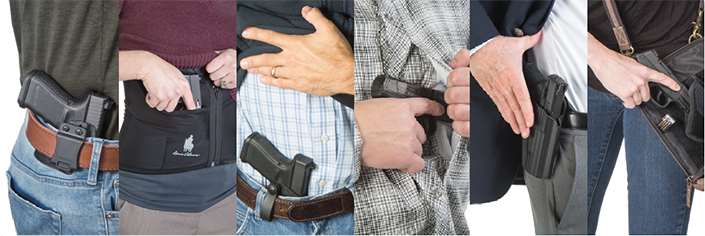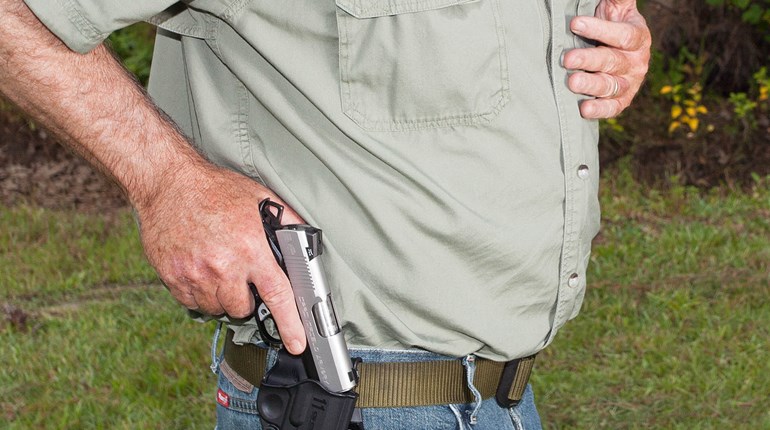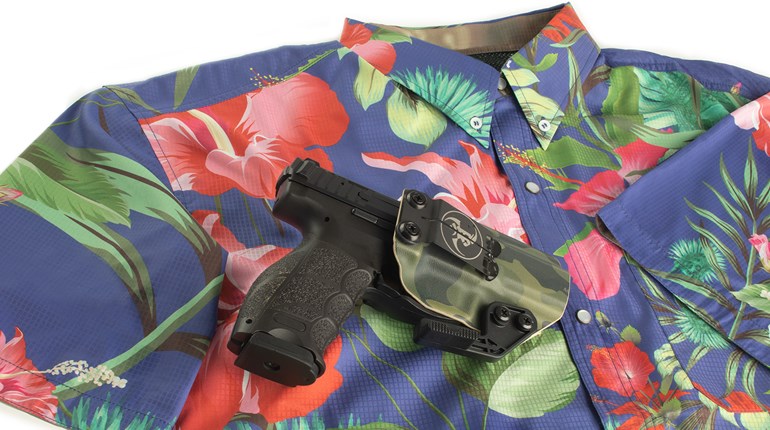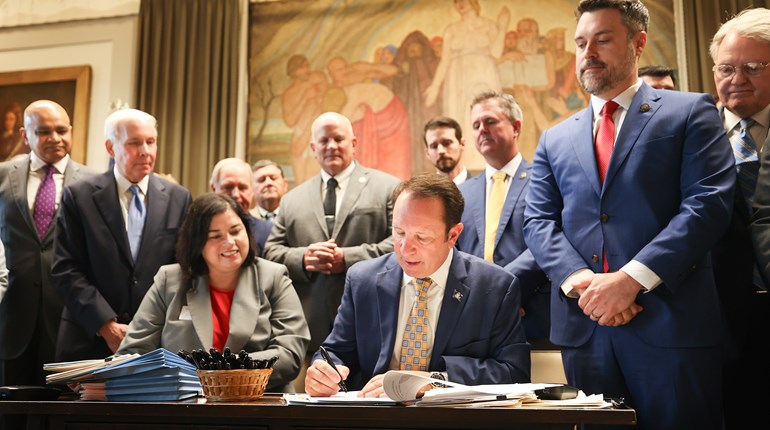
There’s an old Monty Python sketch in which a theatrical radio narrator desperately tries to make an exceedingly boring story sound suspenseful and melodramatic. “June the 4th, 1973,” the voice says, “was much like any other summer’s day in Peterborough, and Ralph Mellish, a file clerk at an insurance company, was on his way to work as usual when ... dah dum dum ... nothing happened!”
The story of the widespread adoption of permitless concealed carry—broadly known as “constitutional carry”—has been similar in nature to the tale of Ralph Mellish.
Despite endless attempts to turn the development into a Wagnerian opera, we are now reaching the point at which nearly half of America’s 50 states have nixed their carry-permitting requirements, and still ... dah dum dum ... nothing has happened.
There has been no associated spike in related crime in these states. There has been no increase in armed confrontations. There hasn’t even been a rise in the number of bureaucratic infractions. There have been no negative consequences at all, but now more Americans can protect themselves until the police arrive.
And yet, each and every time a new state looks to nix its permitting systems, the usual voices still cry “disaster!” As I write, the Pennsylvania House of Representatives is considering adding Pennsylvania to the list of constitutional-carry states, and, in response, their Democrat governor, Tom Wolf, is alleging all the same things gun controllers have since the late 1980s. “I will oppose any bill that reduces gun-safety measures,” Wolf vowed recently, while describing the proposal as “removing gun-safety protections and making it easier to carry a gun.”
At a certain point in American history, one might have forgiven politicians for claiming such things. By the mid-1970s, the Second Amendment was being ignored as a matter of routine, and when, in the following decade, a serious push to fix this began, nobody was quite sure what would happen. It was, of course, always far-fetched that, when faced with the restoration of their rights, Americans would turn their cities into the “Wild West,” but at least those who were making such predictions could point to the novelty of widespread concealed carry as a justification for their concern.
But now? In 2021? With 30 years of evidence to rely upon, these claims are absurd.
At this point, we know that respecting concealed carry does not cause problems. At this point, we know that demanding that permits be granted automatically to the eligible (“shall issue”) does not cause problems. And, at this point, we know that abolishing the permitting system completely does not cause problems. And yet still the carpers carp, and still some of our governments try to put free people through the ringer in service of mere superstition.
Why?
The only plausible line of argument against constitutional carry would be that it increased crime. If it does not increase crime—and we now know that it does not—that argument falls apart instantly. Constitutional carry, remember, does not alter who is eligible to carry a gun and who is not, nor does it alter the criminal penalties that are attached to violations of the law; it merely removes the obstacles in front of those who were never a problem in the first place.
There are now about 20 million concealed-carry perrmit holders in the U.S., and an unknown number in the 21 states that allow constitutional carry.
A permitting process that does nothing of use does not have other virtues that make it worth doing; rather, those bureaucratic impediments become a superfluous time-and-money tax imposed upon the exercise of a natural and constitutional right.
One supposes, it is at least coherent for a person who opposes concealed carry to oppose constitutional carry, too. But it is not at all coherent for someone who supports concealed carry to want to set up fruitless roadblocks in front of those who wish to engage in it. We’re 21 states into this now, and the dire risks we always hear about have materialized precisely nowhere. In fact, quite the opposite has happened: As statistics out of Texas and Florida have shown, concealed carriers are up to six times more law-abiding than the police. In a rational country, that must count for something.
The implication that constitutional carry is the preserve of “extremists” is just as peculiar as the wild predictions of carnage. The states that have adopted constitutional carry are a diverse bunch. Vermont has had it since 1777, and it was joined, in 2015 and 2017 respectively, by fellow New England states Maine and New Hampshire. Texas has it now, but it was beaten to the punch by Kansas, Oklahoma, Arkansas and others. Missouri and Iowa are constitutional-carry states, as are both Dakotas, Montana, Idaho, Utah and Wyoming. So are West Virginia, Arizona and Alaska. In total, 21 states have constitutional carry, and there are bills working their way through the statehouses of yet more. By the time of the next presidential election, it seems possible that constitutional carry states will represent a majority. And by the time the next decade rolls around, it seems equally possible that they will represent a supermajority. This train is a-rollin’.
One of the stranger phenomena within our contemporary politics is the total unwillingness of gun-control activists to update their rhetoric in the face of markedly changed realities on the ground. There are now more guns than people in the United States—as the past few years have shown, gun ownership has increased in popularity among every demographic group—and yet critics of the Second Amendment still insist the right to keep and bear arms is important only to a tiny subset of the population.
There are currently about 20 million concealed-carry permit holders in the U.S., and an unknown number in the 21 states that now allow some type of constitutional carry (as this was being written, Americans can travel through 57% of the landmass of the United States without needing a permit to carry a gun). This being so, it is simply not sustainable to cast carriers as being on the fringe, or to pretend that they are doing something dangerous or unusual or likely to end in tears.
They are not. Within my own circles, I know teachers who carry, doctors who carry, electricians who carry, stay-at-home moms who carry. The classes at my local gun store are always full and the carry guns they recommend to the attendees are often sold out for months at a time. Back in 1959, 60% of Americans favored a total ban on handguns; today, that number is merely 25%, according to a long-running Gallup poll. Properly understood, the recent move toward permitless carry does not violate broader trends; it reflects them.
Those trends have clear political implications—not least because they make it much harder for the opponents of the Second Amendment to gain a strong bureaucratic foothold. As we have seen in less-free states, such as California and New York, a government that can make the citizenry jump through hoops in order to obtain a carry permit is a government that can impose a de facto ban on concealed carry—or, at the very least, it is a government that can concoct a system within which local politicians are able to use their “discretion” and thereby keep guns out of the hands of everyone but a select few. By contrast, a government that concerns itself with nothing beyond the dissemination of universally applicable laws is a government that has scant capacity for mischief.
Better still, by removing permits from the equation, one inverts the underlying presumption. With a permitting system in place, each citizen is obliged to ask the government for permission to exercise his or her rights. With no permitting system, each citizen may assume as a matter of course that he or she is entitled to exercise those rights, subject only to the same discrete limits as apply to everybody else. In effect, constitutional carry serves as a practical reinforcement of the U.S. Supreme Court’s 2008 confirmation that the Second Amendment protects an individual right to bear arms, as well as a means by which to demystify gun ownership by affirming it as an accepted natural right rather than a concession that must be extracted from controlling hands.
As the National African American Gun Association noted recently in the brief it filed with the U.S. Supreme Court against New York’s strict permitting laws, “during the colonial, founding and early republic periods, slaves and even free Blacks, particularly in the southern states, were either barred from carrying a firearm at all or were required to obtain a license to do so, which was subject to the discretion of a government official.”
For drawing a line under that shameful practice, constitutional carry should be regarded not merely as good policy, but as a liberation.
In all likelihood, Americans growing up in this era will have a much more liberty-minded conception of gun rights than Americans who grew up in, say, the locked-down 1970s. History shows us that it is much more difficult to take away rights when they are being used consistently than when they have fallen into disrepair or overregulation, and the Second Amendment is now being used consistently in a manner that it has not been in a century. Just as people who are accustomed to paying no state income tax find it jarring when they move to a state that has one, so, too, Americans who are accustomed to having their rights protected find it strange when they run up against strict permitting requirements.
Especially given that the case for those requirements has been shown to be nonsense. In making their argument, gun-control advocates like to claim that tight rules will lead to better outcomes. But, for the last 30 years, Americans have learned that precisely the opposite is the case. Since 1990, the number of guns in private hands has more than doubled, and the rules governing their ownership and use have been liberalized almost everywhere. At the same time, we largely enjoyed a massive drop in crime—including crime committed with guns. Over time, legal changes lead to cultural changes, which lead to legal changes, which lead to more cultural changes. Maybe, bit by bit, this is one front in the “culture war” that the friends of liberty are winning?
When, in 2010, Arizona became the third state in the union to adopt permitless carry, it was a national story. By 2021, Iowa, Montana, Tennessee, Texas and Utah were adding themselves to the rolls without any negative effects, and, in fact, with plenty of positive impacts as more Americans can defend themselves. So now states can say, this freedom has already spread here and here and here and ... dah dum dum ... nothing bad has happened, but plenty of good has.

Conceal-Carry Nation
The data, as always, is behind the trends.
Concealed-carry data is no exception; in fact, it is getting harder to trust this data for a good reason: As 21 states now have some form of constitutional carry, we don’t have hard numbers from nearly half of the states. Still, the growth in concealed carry over the last few decades has been astounding. At the end of 2020, the Crime Prevention Research Center (CPRC) (find them at crimeresearch.org) determined that at least 19.48 million citizens—a 34% increase over 2016—had permits to carry concealed.
As gun sales have been setting records in 2020, many of the states that still require government authorization for the use of this right have been slower to issue permits. Their excuse has been the pandemic. As a result, John Lott, the president of CPRC, reported that, in 2020, “the number of permit holders continued to grow by about 820,000.” This 4.4% growth over 2019 was “the slowest percent and absolute increase that we have seen since we started collecting this data in 2011.”
Incredibly, as of the end of 2020, about 7.6% of American adults had permits in the states that still require them. In 14 states, more than 10% of adults have permits. Alabama has the highest concealed-carry rate at 28.5%. Florida is the first state to have over 2 million permits.


































